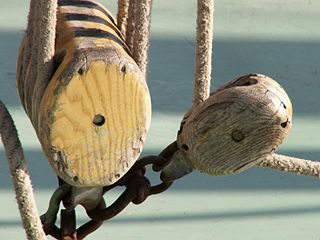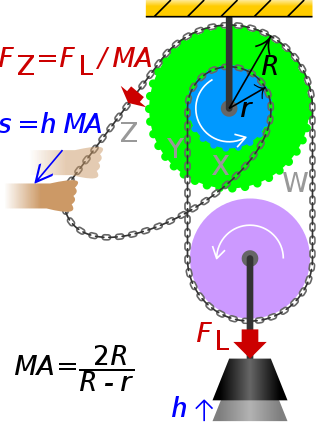Mechanical advantage is a measure of the force amplification achieved by using a tool, mechanical device or machine system. The device trades off input forces against movement to obtain a desired amplification in the output force. The model for this is the law of the lever. Machine components designed to manage forces and movement in this way are called mechanisms. An ideal mechanism transmits power without adding to or subtracting from it. This means the ideal machine does not include a power source, is frictionless, and is constructed from rigid bodies that do not deflect or wear. The performance of a real system relative to this ideal is expressed in terms of efficiency factors that take into account departures from the ideal.

A pulley is a wheel on an axle or shaft that is designed to support movement and change of direction of a taut cable or belt, or transfer of power between the shaft and the cable or belt. In case of a pulley supported by a frame or shell that does not transfer power to a shaft, but is used to guide the cable or exert a force, the supporting shell is called a block, and the pulley may be called a sheave or pulley wheel.

Continuous track or tracked treads are a system of vehicle propulsion used in tracked vehicles, running on a continuous band of treads or track plates driven by two or more wheels. The large surface area of the tracks distributes the weight of the vehicle better than steel or rubber tyres on an equivalent vehicle, enabling continuous tracked vehicles to traverse soft ground with less likelihood of becoming stuck due to sinking.

A chain tool is a small mechanical device used to "break" a bicycle chain in such a way that it can be mended with the same tool. A bicycle chain has links and plates that are pinned together; these pins can be pushed out with the chain tool. Because the pins are pushed out gradually with a screw, they can be partially removed or fully removed, depending upon the intention of the user.

A derailleur is a variable-ratio bicycle gearing system consisting of a chain, multiple sprockets of different sizes, and a mechanism to move the chain from one sprocket to another.

A chainsaw is a saw that cuts with a set of teeth attached to a rotating chain driven along a guide bar. Modern chainsaws are used in activities such as tree felling, limbing, bucking, pruning, cutting firebreaks in wildland fire suppression, harvesting of firewood, for use in chainsaw art and chainsaw mills, for cutting concrete, and cutting ice. Precursors to modern chainsaws were first used in surgery, with patents for wood chainsaws beginning in the late 19th century.

A bicycle chain is a roller chain that transfers power from the pedals to the drive-wheel of a bicycle, thus propelling it. Most bicycle chains are made from plain carbon or alloy steel, but some are nickel-plated to prevent rust, or simply for aesthetics.

Roller chain or bush roller chain is the type of chain drive most commonly used for transmission of mechanical power on many kinds of domestic, industrial and agricultural machinery, including conveyors, wire- and tube-drawing machines, printing presses, cars, motorcycles, and bicycles. It consists of a series of short cylindrical rollers held together by side links. It is driven by a toothed wheel called a sprocket. It is a simple, reliable, and efficient means of power transmission.

The Ford Super High Output (SHO) V8 engine was designed and built by Ford Motor Company in conjunction with Yamaha Motor Corporation for use in the 1996 Ford Taurus SHO. It was based on the successful Ford Duratec engine rather than its predecessor, the compact Ford SHO V6 engine developed by Yamaha for the 1989 Taurus SHO. The engine was retired in 1999 when production of the third-generation Taurus SHO ended.

On a bicycle, the cassette or cluster is the set of multiple sprockets that attaches to the hub on the rear wheel. A cogset works with a rear derailleur to provide multiple gear ratios to the rider. Cassettes come in two varieties, freewheels or cassettes, of which cassettes are a newer development. Although cassettes and freewheels perform the same function and look almost the same when installed, they have important mechanical differences and are not interchangeable.

The o-ring chain is a specialized type of roller chain used in the transmission of mechanical power from one sprocket to another.

A fly system, or theatrical rigging system, is a system of ropes, pulleys, counterweights and related devices within a theater that enables a stage crew to fly (hoist) quickly, quietly and safely components such as curtains, lights, scenery, stage effects and, sometimes, people. Systems are typically designed to fly components between clear view of the audience and out of view, into the large space, the fly loft, above the stage.

A chain is a serial assembly of connected pieces, called links, typically made of metal, with an overall character similar to that of a rope in that it is flexible and curved in compression but linear, rigid, and load-bearing in tension. A chain may consist of two or more links. Chains can be classified by their design, which can be dictated by their use:
Motorcycle components and systems for a motorcycle are engineered, manufactured, and assembled in order to produce motorcycle models with the desired performance, aesthetics, and cost. The key components of modern motorcycles are presented below.

A differential pulley —also called "Weston differential pulley", sometimes "differential hoist", "chain hoist", or colloquially "chain fall"— is used to manually lift very heavy objects like car engines. It is operated by pulling upon the slack section of a continuous chain that wraps around two pulleys on a common shaft. The relative sizing of the two connected pulleys determines the maximum weight that can be lifted by hand. If the pulley radii are close enough, then the load will remain in place until the chain is pulled.

Skip-link chain is an obsolete roller chain for bicycles in which side plates are alternately short and long, and so rollers are alternately close together and far apart.
The saw chain, or cutting chain, is a key component of a chainsaw. It consists of steel links held together by rivets, and superficially resembles the bicycle-style roller chain, although it is closer in design to a leaf chain. Its key differences are sharp cutting teeth on the outside of the chain loop, and flat drive links on the inside, to retain the chain on the saw's bar and allow propulsion by the engine or motor.

A conveyor chain is chain that has been designed specifically for chain conveyor systems. It consists of a series of journal bearings that are held together by constraining link plates. Each bearing consists of a pin and a bush on which the chain roller revolves.

A master link or quick-release link is a roller chain accessory that allows convenient connection and disconnection of a chain without the need for a chain tool. It acts as a set of the chain's outer plates, so joining two sets of the chain's inner plate ends. Such master links may or may not be re-usable. A chain tool is nonetheless needed to adjust a chain's length, for example to shorten a new chain before connecting its ends. They are used on bicycles and motorcycles.

















